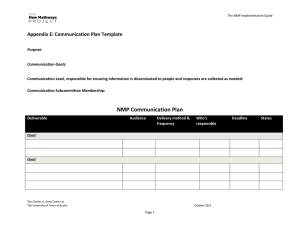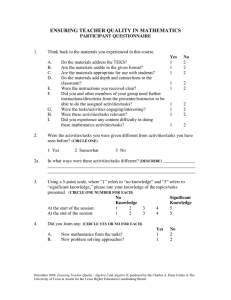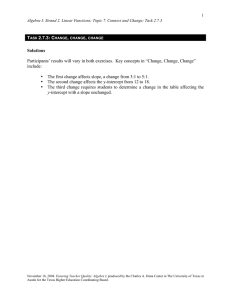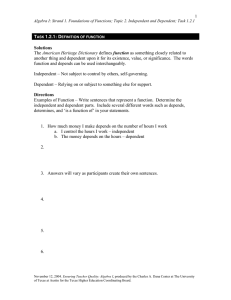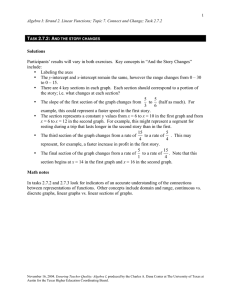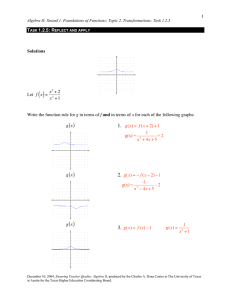Moving Mathematics Teaching into the Networked World
advertisement
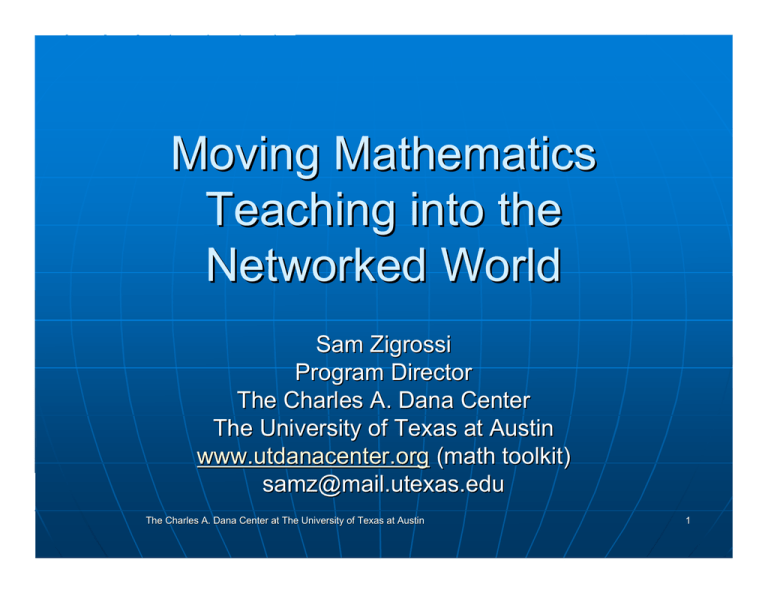
Moving Mathematics Teaching into the Networked World Sam Zigrossi Program Director The Charles A. Dana Center The University of Texas at Austin www.utdanacenter.org (math toolkit) samz@mail.utexas.edu The Charles A. Dana Center at The University of Texas at Austin 1 Objectives To recruit leaders who will constructively challenge what we are doing in mathematics education and assist and support in changing mathematics education so more students can be successful and be able to compete in the 21st century. The Charles A. Dana Center at The University of Texas at Austin 2 My background Born 1941 of Italian immigrants First in the family to attend college Taught high school math and physics Earned MS in Education Administration (algebra dissertation) IBM career of 29 years (MBA) • IBM’s interface with public education Served on two state panels for Texas education Adjunct professor in business school—25 years The Charles A. Dana Center for 10 years The Charles A. Dana Center at The University of Texas at Austin 3 Format of the presentation Review each decade from 1940 to 2008 • Major events of the decade • Drivers of the economy and society • Character of education and mathematics teaching Some perspectives The Charles A. Dana Center at The University of Texas at Austin 4 The 1940s Events • Ending of the war—”The Bomb” • Women move into the workforce in large numbers due to the war. • Thousands of servicemen return, get educated, and fuel the greatest economic growth period (GI Bill). • Transistor is invented. • Jackie Robinson becomes first black man to play major league baseball. • Average annual salary: $2,992 • Labor force male:female is 5:2. • A loaf of bread costs $0.14. The Charles A. Dana Center at The University of Texas at Austin 5 The 1940s Drivers of the economy and society Industrialization increases from war effort. Number of college graduates increases from returning servicemen. Exports and rebuilding of Europe First computer ENIAC (18,000 vacuum tubes) Economy begins to grow in late 1940s. The Charles A. Dana Center at The University of Texas at Austin 6 The 1940s Character of mathematics teaching A select few take algebra and higher-level mathematics in high school. Mathematics teaching is based on college teaching pedagogy. Textbook-driven, lecture, homework Majority of students take “arithmetic” courses. Education model is based on the Industrial Revolution model. The Charles A. Dana Center at The University of Texas at Austin 7 The 1950s Events • Industrial revolution is maturing, moving into the service economy. • Nuclear applications begin. • First cake mix is introduced. • Drive-in movies • Automobile opens up travel. • U.S. is greatest industrial nation—no other country even close. The Charles A. Dana Center at The University of Texas at Austin 8 The 1950s Drivers of the economy and society Integrated circuit is invented. Transcontinental TV begins. McCarthy hearings; communism Rosa Parks refuses to give up her seat on a public bus. Sputnik—first satellite orbits Earth. U.S launches Explorer I. Economy expansion is significant. Radio is prime information and entertainment media in the home. Salk vaccine is developed to halt polio epidemic. The Charles A. Dana Center at The University of Texas at Austin 9 The 1950s Character of mathematics teaching “Separate but equal” education is challenged. Brown v. Board of Education of Topeka, U.S. Supreme Court decision: “separate educational facilities are inherently unequal.” Mathematics teaching is still much the same as it was in the 1940s. Higher-level math courses available only for the brightest students. Traditional teaching—whole group. Sputnik causes the country to focus on mathematics and science education; many people have ideas of what to change—a great amount of rhetoric. The Charles A. Dana Center at The University of Texas at Austin 10 The 1960s Events • Vietnam War • Civil Rights movement becomes a focal point of society. • Civil Rights Act of 1964 • NASA is established. • John Glenn orbits Earth three times. • TI handheld calculator: $2,500 • Bay of Pigs and Cuban missile crisis • JFK is assassinated. The Charles A. Dana Center at The University of Texas at Austin 11 The 1960s Drivers of the economy and society Space research and engineering Apollo program Building of U.S. infrastructure Consumer products • TV in most homes Most products are American-made. Computers make significant inroads into business—IBM, HP, Cray, Apple TV is main media in home for entertainment and news. The Charles A. Dana Center at The University of Texas at Austin 12 The 1960s Character of mathematics teaching “New Math” is introduced into schools via National Science Foundation—focus on concepts, set theory, functions and diagrams. Public and teachers rebel and go back to traditional teaching of mathematics. Programmed instruction is introduced. Segregation is still common. Much rhetoric about improving schools Integration begins in public schools. The Charles A. Dana Center at The University of Texas at Austin 13 The 1970s Events • • • • • Roe v. Wade U.S. Supreme Court decision School-sponsored prayer is unconstitutional. Impeachment proceedings for President Nixon Vietnam War divides the country. Affirmative action becomes a key consideration for business in hiring. “Glass Ceiling” concept is popularized. The Charles A. Dana Center at The University of Texas at Austin 14 The 1970s Drivers of the economy and society Travel—jumbo jets Genetic engineering First “test tube” baby is born. Intel’s first microprocessor Entertainment—introduction of VCRs First Star Wars movie, The Godfather, Jaws, American Graffiti, Grease Significant stock market decline The Charles A. Dana Center at The University of Texas at Austin 15 The 1970s Character of mathematics teaching Relatively little has changed in mathematics teaching from the 1960s—some believe education lost the impetus of the 1960s. School integration is in full swing. The federal Education for All Handicapped Children Act is passed (1975; now called Individuals with Disabilities Education Act—IDEA). Computer-Assisted Instruction (CAI) becomes part of business training—that is the next phase of programmed instruction. There is significant rhetoric about public education. The Charles A. Dana Center at The University of Texas at Austin 16 The 1980s Events • • • • • • • • Business hostile takeovers and megamergers AIDS becomes significant issue. Berlin Wall comes down. Buying on credit becomes the norm. Rescue mission to Iran fails. First Space Shuttle—Columbia—orbits Earth. U.S. Hockey team beats the Soviet Union. Sandra Day O’Connor appointed to U.S. Supreme Court. The Charles A. Dana Center at The University of Texas at Austin 17 The 1980s Drivers of the economy and society Personal computers become legitimate tools in business. Microsoft Disk Operating System (MS-DOS) is introduced by IBM. Imports gain large market share in automobiles and consumer electronics. Inflation 13+%—prime rate 21% Internet opens up to selected groups. The Charles A. Dana Center at The University of Texas at Austin 18 The 1980s Character of education A Nation at Risk report: “If an unfriendly foreign power had attempted to impose on America the mediocre educational performance that exists today, we might well have viewed it as an act of war. As it stands, we have allowed this to happen to ourselves. We have even squandered the gains in student achievement made in the wake of the Sputnik challenge. Moreover, we have dismantled essential support systems which helped make those gains possible. We have, in effect, been committing an act of unthinking, unilateral educational disarmament.” The Charles A. Dana Center at The University of Texas at Austin 19 The 1980s Character of mathematics teaching Reform in Texas—Ross Perot 1984 report • Essential Elements • Texas Assessment of Basic Skills (TABS) Stand and Deliver—Jamie Escalante’s work at Garfield High School Significant rhetoric about public education National Science Board report on precollege education in math, science and technology—”The nation that dramatically and boldly lead the world into the age of technology is failing to provide its own children with intellectual tools needed for the 21st century.” • We continue to lead due to our best students and our universities. • What is needed is a new set of “basics”— communications, problem solving, technology literacy. The teaching of mathematics in some states is beginning to be based on a set of standards—pedagogy changes little. The Charles A. Dana Center at The University of Texas at Austin 20 The 1990s Events • • • • Americans with Disabilities Act (ADA) Brady Bill—gun control Persian Gulf War Social Security, gun control, and health care are significant issues. • Famous trials—Rodney King; O.J. Simpson • Columbine High School shooting The Charles A. Dana Center at The University of Texas at Austin 21 The 1990s Drivers of the economy and society World Wide Web grows from 2 million to 100 million users (assimilation of computer technology begins). Imports continue to make gains. Outsourcing jobs Importing skills—HB-1 Visa program Stock market declines. Cell phones become a “must” for everyone. Medical technology is racing with many new applications and popular use of CAT scans, artificial pacemakers, less-invasive surgeries—physicians’ jobs and health care change dramatically. The Charles A. Dana Center at The University of Texas at Austin 22 The 1990s Character of education The decade of brain research: • Previous research— research—cognition and behavior • New research— research—cognitive thinking styles, preference for sense/senses, personality/emotional factors, environmental and emotional factors, physiology/ genetics, physical health, comfort and developmental stages • The brain is a malleable organ. Governor's Education Summit— Summit—The U.S. will be first in math and More rhetoric. science by 2000. President Clinton: "We know, purely and simply, that every single child must have access to a computer, must understand it, must have access to good software and good teachers and to the Internet, so that every person will have the opportunity to make the most of his or her own life." The Charles A. Dana Center at The University of Texas at Austin 23 The 1990s Character of mathematics teaching Standards-based curriculum becomes the norm. The “math wars”—direct vs. conceptual In Texas, the EEs are replaced by the TEKS, and TAAS is introduced. The teaching of mathematics changes a little, with the introduction of technology and the use of more manipulatives. The Charles A. Dana Center at The University of Texas at Austin 24 The 1990s Character of education 83% of students graduate from high school. Distance education Year-round school Dual or concurrent credit School-to-work and Tech Prep Reforms take place—standards-based education begins in early grades. The Charles A. Dana Center at The University of Texas at Austin 25 The 1990s Character of mathematics teaching Majority of students take Algebra I and higher-level math courses. Handheld calculators are introduced in significant numbers in schools. Educational ideology wars create confusion among educators and the public. The Charles A. Dana Center at The University of Texas at Austin 26 The 2000s Events • Communications integration, common use of cell phones, Internet, and digital TV • Genetic engineering • Fossil fuel demand is outstripping supply. • 9/11—war on terrorism • $100 in 1940 is same as $1,322 today. • Average annual salary is $37,000 vs. $2,992 in 1940. • Labor force male:female is 1:1 vs. 5:2 in 1940. • Loaf of bread costs $1.00 vs. $0.14 in 1940. The Charles A. Dana Center at The University of Texas at Austin 27 The 2000s Drivers of the economy and society Consumer spending is key to economy. Housing sector is key element. New communications technologies Oil prices are steadily increasing. Social issues revolve around Social Security, education, personal security, and health care Iraq War and peacekeeping mission The Charles A. Dana Center at The University of Texas at Austin 28 The 2000s Character of mathematics teaching Mathematics teaching has not changed significantly from the 1990s. 2003 task force on education • • • • U.S. 4th graders are competitive internationally. U.S. 8th graders lose 40 points and rate as average. 12th graders are ranked at the very bottom. More rhetoric. Texas scores on NAEP—4th graders are fifth in the country, 8th graders are in the middle, and 11th graders are in the lower third. The Charles A. Dana Center at The University of Texas at Austin 29 The 2000s Character of mathematics teaching 21st Century Summit: What students need: • Digital-age literacy Literacy in all technologies Inventive thinking Problem solving using tools • Effective communications High productivity Collaborate Interactive Social responsibility The Charles A. Dana Center at The University of Texas at Austin Planning Use of tools Produce products 30 16 Career Clusters The Charles A. Dana Center at The University of Texas at Austin 31 Some perspectives Americans have wanted schools to serve different and often contradictory purposes for their own children. • To socialize them to be obedient, yet teach them to be critical thinkers. • To pass on the best academic knowledge that the past has to offer, yet also teach marketable and practical skills. • To cultivate cooperation, yet teach students to compete with one another in school and later life. • To stress basic skills but also encourage creativity and higherorder thinking skills. • To focus on academic “basics,” yet permit a wide range of choice of courses. The Charles A. Dana Center at The University of Texas at Austin 32 Some perspectives 20th Century had many education reforms: • • • • • • New America Schools Accelerated Schools Basic Education Engaged Learning Atlas Success for All Essential Schools American Choice Direct Instruction Purpose Centered Co-NECT ???????????? More rhetoric! Major barriers: • • • In U.S. 3 million teachers, 50 million students In Texas 250,000 teachers, 4 million students Governance The Charles A. Dana Center at The University of Texas at Austin 33 Some perspectives In the 1940s, math teaching was based on textbooks and chalkboards— the “Industrial Model.” In 2008, mathematics is based on ??? • Textbooks???? • Chalkboards/whiteboards??? • Technology??? • Direct instruction??? • Conceptual understanding??? • Standards?????? • What???????? Have we changed enough to reflect the changes that occurred in society to meet society’s need? I don’t think so. The Charles A. Dana Center at The University of Texas at Austin 34 Some perspectives Change Society Public Education Time The Charles A. Dana Center at The University of Texas at Austin 35 Some perspectives As a profession, we lack vision of where we need to go. We are victims of society, government, unenlightened school leadership, and OURSELVES!! The Charles A. Dana Center at The University of Texas at Austin 36 Some perspectives How do we start????? Start simple and then progress to the complex. Let’s look at the research— The Charles A. Dana Center at The University of Texas at Austin 37 Some perspectives The essentials for improving student achievement include: • All students must have access to the same viable curriculum in every classroom— ”guaranteed.” • High-yield instructional strategies have significant effects on student achievement. • Teachers must collaborate to strengthen student achievement—we are all in this together: let’s build a system!! • State standards are the basics, not the goal; go beyond the standards. The Charles A. Dana Center at The University of Texas at Austin 38 Conclusions Is our current Industrial Model of Education what we need in the 21st Century? NO!! Let’s all start looking at new ways of doing things. I believe you have many of the answers but need to have the opportunity and responsibility to begin to revolutionize the teaching of mathematics. The Charles A. Dana Center at The University of Texas at Austin 39 Some perspectives Why do it? • For our next generations of leaders, workers, members of society • To maintain our economic leadership • The next generation is our “kids” who are in school now!! The Charles A. Dana Center at The University of Texas at Austin 40 Future trends Technology Health care Education Energy Environment The Charles A. Dana Center at The University of Texas at Austin 41 Moving Mathematics Teaching into the Networked World Sam Zigrossi Program Director Charles A. Dana Center University of Texas www.utdanacenter.org-(math toolkit) samz@mail.utexas.edu The Charles A. Dana Center at The University of Texas at Austin 42
